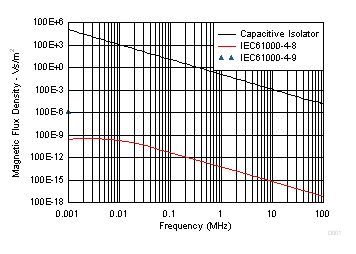SLLA334B August 2018 – September 2022 ISO1050 , SN6501
2 Capacitive Isolation Technology
ISO1050 transceiver is an isolated CAN transceiver with a maximum data rate of 1 Mbps and 4 kV of galvanic isolation. The ISO1050 transceiver meets or exceeds all requirements of the ISO 11898 standard. This device uses capacitive isolation technology (SiO2) for signal path isolation. Compared to inductive and optocoupler type, the main advantage of SiO2 capacitive isolation is high reliability and long-life time expectancy, which benefits from its small aging effect characteristic. With an industry lifetime requirement at 400 V (minimum) working voltage, inductive type has only 8 years while capacitive isolator has a significantly longer lifetime of 28 years.
 Figure 2-1 Magnetic Field Immunity
Figure 2-1 Magnetic Field ImmunityDue to internal design construction of capacitive isolators, this type of isolator provides almost infinitely high magnetic field immunity. Figure 2-1 describes the quantified magnetic immunity (the field-strength is applied without causing false toggling). Figure 2-1 shows outstanding performance of the capacitive device, which is far beyond the standard of IEC 61000-4-8 and IEC 61000-4-9.
Another benefit of using SiO2 capacitive technology is that it is compatible with standard semiconductor manufacturing processes. Therefore, lower production cost is achieved, thus bringing the lower cost to customer directly.